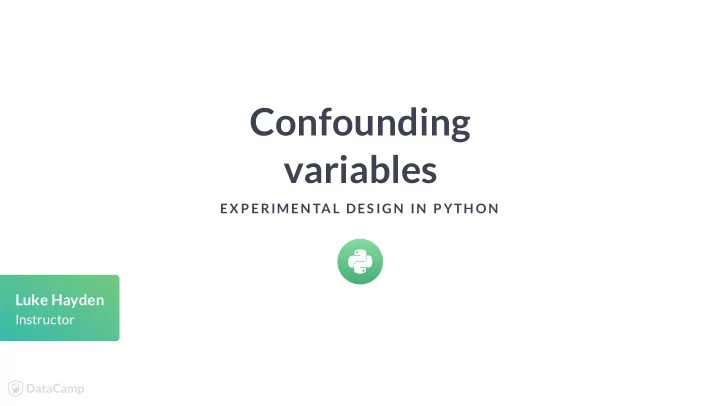

Confounding variables EX P ERIMEN TAL DES IGN IN P YTH ON Luke Hayden Instructor
Confounding variables Confounding variable Additional variable not accounted for in study design Alters the independent and dependent variables Example Examining children's test scores Expensive cars and higher test scores in school correlate Reliable? Actually due to confounding Both linked to family income EXPERIMENTAL DESIGN IN PYTHON
Obvious conclusion? print(p9.ggplot(df)+ p9.aes(x= 'Team', y= 'Weight')+ p9.geom_boxplot()) EXPERIMENTAL DESIGN IN PYTHON
Maybe not... print(p9.ggplot(df)+ p9.aes(x= 'Team', y= 'Weight', fill="Event")+ p9.geom_boxplot()) EXPERIMENTAL DESIGN IN PYTHON
Interpretation Differences could be due to: 1. Country 2. Event 3. Country & event Dif�cult to choose between these Event is a confounding variable EXPERIMENTAL DESIGN IN PYTHON
Let's practice! EX P ERIMEN TAL DES IGN IN P YTH ON
Blocking and randomization EX P ERIMEN TAL DES IGN IN P YTH ON Luke Hayden Instructor
Making comparisons Compare like with like Only variable of interest should differ between groups Remove sources of variation See variation of interest EXPERIMENTAL DESIGN IN PYTHON
Random sampling Simple way to assign to treatments import pandas as pd from scipy import stats seed= 1916 subset_A = df[df.Sample == "A"].sample(n= 30, random_state= seed) subset_B = df[df.Sample == "B"].sample(n= 30, random_state= seed) t_result = stats.ttest_ind(subset_A.value, subset_B.value) EXPERIMENTAL DESIGN IN PYTHON
Other sources of variation Example Two potato varieties: Roosters & Records Two fertilizers: A & B Variety could be a confounder EXPERIMENTAL DESIGN IN PYTHON
Blocking Solution to confounding Control for confounding by balancing with Design respect to other variable Variety Fertilizer A Fertilizer B Example Records 10 10 Equal proportions of each variety treated with each fertilizer Roosters 10 10 EXPERIMENTAL DESIGN IN PYTHON
Implementing a blocked design import pandas as pd block1 = df[(df.Variety == "Roosters") ].sample(n=15, random_state= seed) block2 = df[(df.Variety == "Records") ].sample(n=15, random_state= seed) fertAtreatment = pd.concat([block1, block2]) EXPERIMENTAL DESIGN IN PYTHON
Paired samples Special case 2017 yield 2018 yield (tons/hectare) (tons/hectare) Control for individual variation 60.2 63.2 Increase statistical power by reducing noise Example 12 15.6 13.8 14.8 Yield of 5 �elds before/after change of fertilizer 91.8 96.7 50 53 EXPERIMENTAL DESIGN IN PYTHON
Implementing a paired t-test from scipy import stats yields2018= [60.2, 12, 13.8, 91.8, 50] yields2019 = [63.2, 15.6, 14.8, 96.7, 53] ttest = stats.ttest_rel(yields2018,yields2019) print(ttest[1]) p-value: 0.007894143467973484 EXPERIMENTAL DESIGN IN PYTHON
Let's practice! EX P ERIMEN TAL DES IGN IN P YTH ON
ANOVA EX P ERIMEN TAL DES IGN IN P YTH ON Luke Hayden Instructor
Variable types Independent (Factors) Manipulate experimentally Dependent Try to understand their patterns t-test One discrete independent variable with two levels One dependent variable EXPERIMENTAL DESIGN IN PYTHON
ANOVA Analysis of variance Generalize t-test to broader set of cases Examine multiple factors/levels Approach Partition variation into separate components Multiple simultaneous tests EXPERIMENTAL DESIGN IN PYTHON
One-way ANOVA Use One factor with 3+ levels Does factor affect sample mean? Example: Does potato production differ between three fertilizers? EXPERIMENTAL DESIGN IN PYTHON
Implementing a one-way ANOVA from scipy import stats array_fertA = df[df.Fertilizer == "A"].Production array_fertB = df[df.Fertilizer == "B"].Production array_fertC = df[df.Fertilizer == "C"].Production anova = stats.f_oneway(array_fertA, array_fertB, array_fertC) print(anova[1]) 0.00 EXPERIMENTAL DESIGN IN PYTHON
Two-way ANOVA Use Two factors with 2+ levels Does each factor explain variation in the dependent variable? Example 2 fertilizers, 2 potato varieties Potato production (dependent variable) EXPERIMENTAL DESIGN IN PYTHON
Implementing a two-way ANOVA import statsmodels as sm formula = 'Production ~ Fertilizer + Variety' model = sm.api.formula.ols(formula, data=df).fit() aov_table = sm.api.stats.anova_lm(model, typ=2) print(aov_table) sum_sq df F PR(>F) Fertilizer 1.0 p-value Variety 1.0 p-value Residual NaN NaN EXPERIMENTAL DESIGN IN PYTHON
Example EXPERIMENTAL DESIGN IN PYTHON
Example output import statsmodels as sm formula = 'Production ~ Fertilizer + Variety' model = sm.api.formula.ols(formula, data=df).fit() aov_table = sm.api.stats.anova_lm(model, typ=2) print(aov_table) sum_sq df F PR(>F) Fertilizer 16247.966193 1.0 16347.749306 0.0 Variety 15881.785333 1.0 15979.319631 0.0 Residual 3972.603180 3997.0 NaN NaN EXPERIMENTAL DESIGN IN PYTHON
Let's practice! EX P ERIMEN TAL DES IGN IN P YTH ON
Interactive effects EX P ERIMEN TAL DES IGN IN P YTH ON Luke Hayden Instructor
Additive model EXPERIMENTAL DESIGN IN PYTHON
Interactive effects In this example: Fertilizer D only better for Rooster potatoes EXPERIMENTAL DESIGN IN PYTHON
Interactive effects In this example: Fertilizer E is best for Roosters Fertilizer F is best for Records EXPERIMENTAL DESIGN IN PYTHON
Implementing ANOVA with interactive effects import statsmodels as sm formula = 'Production ~ Fertilizer + Variety + Fertilizer:Variety' model = sm.api.formula.ols(formula, data=df).fit() aov_table = sm.api.stats.anova_lm(model, typ=2) print(aov_table) sum_sq df F PR(>F) Fertilizer 1.0 p-value Variety 1.0 p-value Fertilizer:Variety 1.0 p-value Residual NaN NaN EXPERIMENTAL DESIGN IN PYTHON
Example 1 EXPERIMENTAL DESIGN IN PYTHON
Interactive effect import statsmodels as sm formula = 'Production ~ Fertilizer + Variety + Fertilizer:Variety' model = sm.api.formula.ols(formula, data=df).fit() aov_table = sm.api.stats.anova_lm(model, typ=2) print(aov_table) sum_sq df F PR(>F) Fertilizer 56425.833205 1.0 60222.992593 0.0 Variety 56049.056459 1.0 59820.860770 0.0 Fertilizer:Variety 55385.556078 1.0 59112.710332 0.0 Residual 3744.045584 3996.0 NaN NaN EXPERIMENTAL DESIGN IN PYTHON
Example 2 EXPERIMENTAL DESIGN IN PYTHON
No interactive effect import statsmodels as sm formula = 'Production ~ Fertilizer + Variety + Fertilizer:Variety' model = sm.api.formula.ols(formula, data=df).fit() aov_table = sm.api.stats.anova_lm(model, typ=2) print(aov_table) sum_sq df F PR(>F) Fertilizer 15468.395105 1.0 15172.001139 0.000000 Variety 16010.275045 1.0 15703.497977 0.000000 Fertilizer:Variety 1.464654 1.0 1.436589 0.230763 Residual 4074.064210 3996.0 NaN NaN EXPERIMENTAL DESIGN IN PYTHON
Beyond 2-way ANOVA Two-way ANOVA Three-way ANOVA formula = 'Production ~ formula = 'Production ~ Fertilizer + Fertilizer + Variety + Fertilizer:Variety' Variety + Season + Fertilizer:Variety + Fertilizer:Season + Variety:Season + Fertilizer:Variety:Season' 3 variables, 3 p-values 2 factors, 1 interaction 7 variables, 7 p-values 3 factors, 4 interactions EXPERIMENTAL DESIGN IN PYTHON
Let's practice! EX P ERIMEN TAL DES IGN IN P YTH ON
Recommend
More recommend